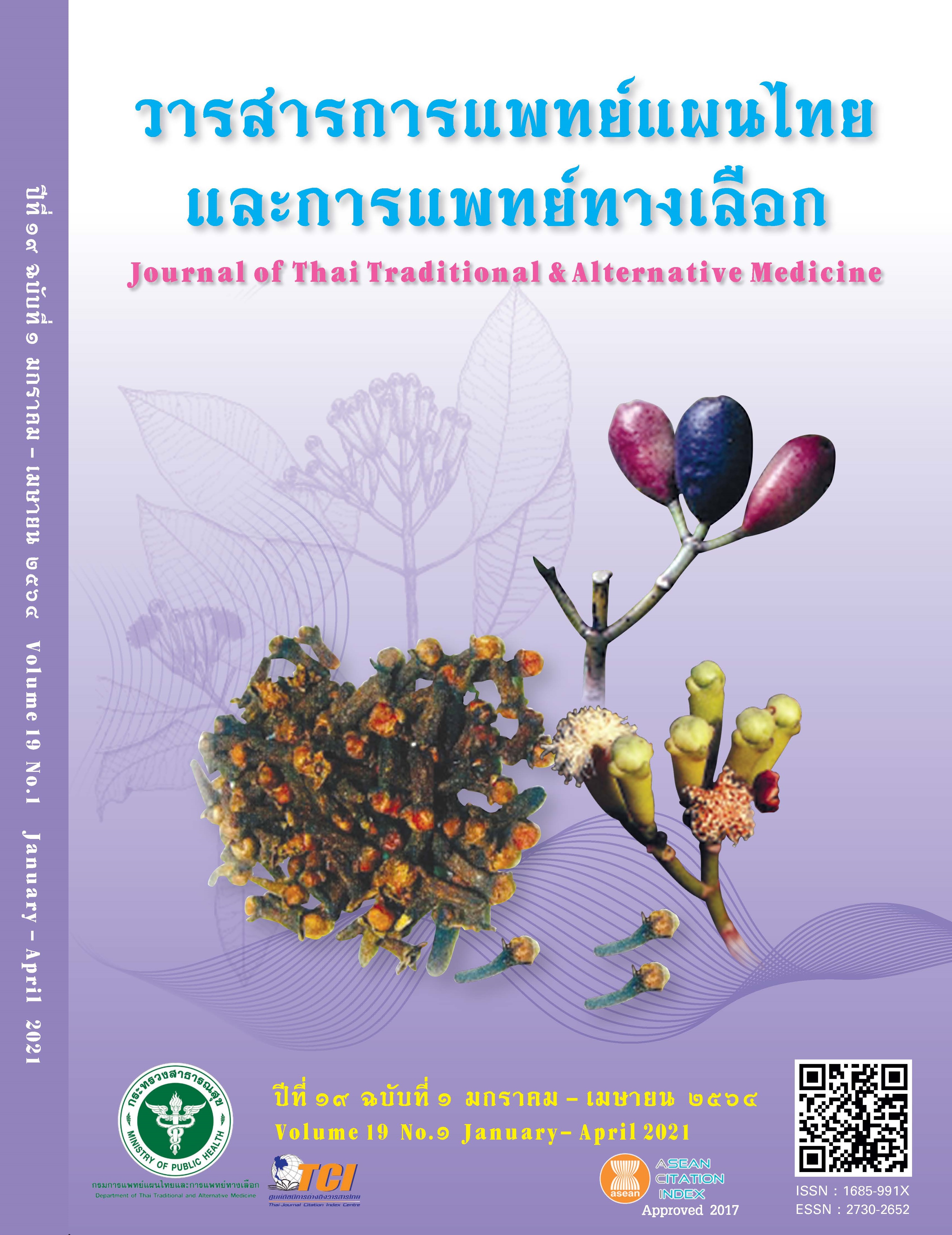Effectiveness of Cannabis Extract at Medical Cannabis Clinic in Lampang Hospital
Main Article Content
Abstract
In the past, the consumption of cannabis for any purpose was prohibited by law in Thailand; thus, there was no research on the efficacy and safety of cannabis conducted by Thai researchers. However, in 2019, Thailand began to legalize cannabis for medical treatment and research. Lampang Hospital is one of the hospitals in the country that has set up a medical cannabis clinic. The cannabis extract used in our clinic is GPO THC oil 0.5 mg/drop. The objective of this research was to determine the clinical outcomes of patients after receiving cannabis extract. It was a time series study collecting prospective data on patients visiting the Medical Cannabis Clinic at Lampang Hospital from 28 August 2019 to 30 June 2020. The quality of life scores measured by EQ-5D-5L questionnaire and pain scores were collected and compared at each clinic visit using repeated measure ANOVA and Friedman test. The results showed that, among a total of 85 patients participating in this study, the mean age was 59.4 ± 12 years; 54% were male and 41% had received cannabis prior to their visit to the clinic. The common purposes of using cannabis extract were for palliative treatment (53%) and relieving pain (40%), migraine (4%), insomnia (2%), and nausea/vomiting from chemotherapy (1%). A total of 50 patients were followed up for 10 visits. For the efficacy, the median quality of life score significantly increased [0.016 (-0.131, 0.279); -0.283-0.960 vs 0.132(-0.204,0.703); -0.204-0.703,P < 0.001] and the mean pain score significantly decreased (8.24±2.3vs5.00±2.0, P < 0.001). For safety, 9 patients (10.6%) hadside effects from cannabis when Naranjo’salgorithm wasused; 3 of whom had to discontinue cannabis due to cannabis-induced psychosis, disorientation, and abnormal blood pressure, and 6 were able to continue cannabis despite experiencing such side effects as nausea, vomiting, dizziness, dry mouth, palpitation, hypersomnolence, and euphoria. Therefore,based on the results, cannabis can increase the
qualityof life, decrease pain and should be regarded as an alternative medication for specific patients.
Article Details
References
Amato L, Minozzi S, Mitrova Z, Parmelli E, Saulle R, Cruciani F, VecchiS, Davoli M . Systematic review
of safeness and therapeutic efficacy of cannabis in patients with multiple sclerosis,neuropathicpain, and
in oncological patients treated with chemotherapy. Epidemiologia eprevenzione. 2017;41(5-6):279-93.
Andreae MH, Carter GM, Shaparin N, Suslov K, Ellis RJ, Ware MA, Abrams DI, Prasad H, WilseyB, Indyk
D, Johnson M, Sacks HS. Inhaled cannabis for chronic neuropathicpain:a meta-analysisof individualpatient
data. The Journal ofPain. 2015;16(12):1221-32.
NationalAcademiesofSciencesE,Medicine.Thehealth effectsofcannabisandcannabinoids: thecurrent state of evidence and recommendations for research (2017). National AcademiesPress; 2017.
Cuestas E. Cannabis for chronic neuropathic pain. Revista de la Facultad de Ciencias Medicas (Cordoba,Argentina). 2019;76(1):1-2.
Sexton M, Cuttler C, Finnell JS, Mischley LK. A cross-sectional survey of medical cannabis users: patterns of use and perceived efficacy. Cannabis and cannabinoid research. 2016;1(1):131-8.
Aggarwal SK, Carter GT, Sullivan MD, ZumBrunnen C, MorrillR, Mayer JD. Characteristics of patients with
chronic pain accessing treatment with medical cannabis in Washington State. Journal of Opioid Management.
;5(5):257-86.
Li X, Vigil JM, Stith SS, Brockelman F, KeelingK, Hall B. The effectiveness of self-directed medical cannabis treatment for pain. Complementary therapies in medicine. 2019;46:123-30.
Haroutounian S, Ratz Y, Ginosar Y, Furmanov K, Saifi F, Meidan R, Davidson E. The effect of medicinal cannabis on pain and quality-of-life outcomes in chronic pain: A Prospective Open-label Study. The Clinical journal of pain. 2016;32(12):1036-43.
Abuhasira R, Schleider LB-L, Mechoulam R, Novack V. Epidemiological characteristics, safety and efficacy of medical cannabis in the elderly. Europeanjournal of internal medicine. 2018;49:44-50.
Bohnert KM, Bonar EE, Arnedt JT, Conroy DA, Walton MA, Ilgen MA. Addictive Behaviors Utility of the comprehensive marijuana motives questionnaire among medical cannabis patients. 2018.
Elliott J, McCoy B, Clifford T, Potter BK, Wells GA, Coyle D. Economic Evaluation of Cannabinoid Oil for Dravet Syndrome: A Cost-Utility Analysis. Pharmaco Economics. 2020:38(9):971-80


